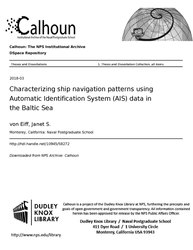File:Characterizing ship navigation patterns using Automatic Identification System (AIS) data in the Baltic Sea (IA characterizingsh1094558272).pdf

Original file (1,275 × 1,650 pixels, file size: 1.1 MB, MIME type: application/pdf, 86 pages)
Captions
Captions
Summary[edit]
| Characterizing ship navigation patterns using Automatic Identification System (AIS) data in the Baltic Sea
( |
||
|---|---|---|
| Author |
von Eiff, Janet S. |
|
| Title |
Characterizing ship navigation patterns using Automatic Identification System (AIS) data in the Baltic Sea |
|
| Publisher |
Monterey, California: Naval Postgraduate School |
|
| Description |
The Intelligence, Surveillance, and Reconnaissance (ISR) community is interested in developing a model that can assist in characterizing patterns of ship navigation. We examine techniques used to highlight those patterns using historical Automatic Identification System (AIS) data in the Baltic Sea from January to April 2014. A regression model is used to determine which factors influence the amount of time a cargo ship spends in a port in the Saint Petersburg, Russia, area. We find that the best model is able to explain about 29 percent of the variance of the length of time that a vessel is in the Saint Petersburg area. We use three random forest models, that differ in their use of past information, to predict a vessel’s next port of visit. The random forest models we use in this analysis demonstrate that predicting a vessel’s next port of call is not a Markov model but a higher-order network where past information is used to more accurately predict the future state. The transitional probabilities change when predictor variables are added that reach deeper into the past. Our findings suggest that successful prediction of the movement of a vessel depends on having accurate information on its recent history. Subjects: AIS; Baltic Sea; data analysis; regression; higher-order network; Bayes information criterion; random forest |
|
| Language | English | |
| Publication date | March 2018 | |
| Current location |
IA Collections: navalpostgraduateschoollibrary; fedlink |
|
| Accession number |
characterizingsh1094558272 |
|
| Source | ||
| Permission (Reusing this file) |
This publication is a work of the U.S. Government as defined in Title 17, United States Code, Section 101. Copyright protection is not available for this work in the United States. | |
Licensing[edit]
| Public domainPublic domainfalsefalse |
This work is in the public domain in the United States because it is a work prepared by an officer or employee of the United States Government as part of that person’s official duties under the terms of Title 17, Chapter 1, Section 105 of the US Code.
Note: This only applies to original works of the Federal Government and not to the work of any individual U.S. state, territory, commonwealth, county, municipality, or any other subdivision. This template also does not apply to postage stamp designs published by the United States Postal Service since 1978. (See § 313.6(C)(1) of Compendium of U.S. Copyright Office Practices). It also does not apply to certain US coins; see The US Mint Terms of Use.
|
 | |
| This file has been identified as being free of known restrictions under copyright law, including all related and neighboring rights. | ||
https://creativecommons.org/publicdomain/mark/1.0/PDMCreative Commons Public Domain Mark 1.0falsefalse
File history
Click on a date/time to view the file as it appeared at that time.
| Date/Time | Thumbnail | Dimensions | User | Comment | |
|---|---|---|---|---|---|
| current | 15:06, 15 July 2020 |  | 1,275 × 1,650, 86 pages (1.1 MB) | Fæ (talk | contribs) | FEDLINK - United States Federal Collection characterizingsh1094558272 (User talk:Fæ/IA books#Fork8) (batch 1993-2020 #11229) |
You cannot overwrite this file.
File usage on Commons
The following page uses this file:
Metadata
This file contains additional information such as Exif metadata which may have been added by the digital camera, scanner, or software program used to create or digitize it. If the file has been modified from its original state, some details such as the timestamp may not fully reflect those of the original file. The timestamp is only as accurate as the clock in the camera, and it may be completely wrong.
| Short title | Characterizing ship navigation patterns using Automatic Identification System (AIS) data in the Baltic Sea |
|---|---|
| Image title | |
| Author | von Eiff, Janet S. |
| Keywords |
|
| Software used | von Eiff, Janet S. |
| Conversion program | Adobe PDF Library 11.0 |
| Encrypted | no |
| Page size | 612 x 792 pts (letter) |
| Version of PDF format | 1.4 |

